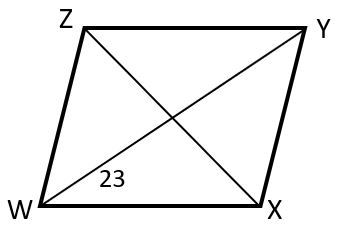Area of rhombus formula
We have a specialized formula to find the area of a rhombus. Consider the following rhombus with diagonals of length d1 and d2.
 Rhombus with diagonals d1 and d2 - Nilabhro Datta, StudySmarter Originals
Rhombus with diagonals d1 and d2 - Nilabhro Datta, StudySmarter Originals
The area of the rhombus is given by the formula:
Since a rhombus is a special case of a parallelogram, the formula for finding the area of a parallelogram also applies to a rhombus and can be used to find the area of any rhombus as well. Consider the following parallelogram.
 Parallelogram with base b and height h - Nilabhro Datta, StudySmarter Originals
Parallelogram with base b and height h - Nilabhro Datta, StudySmarter Originals
The area of a parallelogram is given by the formula:
Area of a parallelogram = b × h
where b = base, h = height
Now the value, b, is the length of the side AB, which is considered the base here. Conventionally, one of the longer sides of the parallelogram is taken to be the base. However, since all sides of a rhombus are equal, any side can be considered the base. Also the height or altitude would be the same no matter which side is taken as the base. In the parallelogram shown above, we can see that the sides are not all equal lengths, which means this parallelogram is not a rhombus.
Note that for area we always use square units. So if we are using the SI units for example, the SI unit of length is meter (m), which means that the SI unit of area would be square meter (m²).
Examples: Area of rhombus equation
Let us look at some example problems related to the area of rhombuses.
The area of rhombus WXYZ shown below is 138 in2. Find the length in inches of the diagonal XZ.

Solution
We know that for a rhombus:
Therefore:
id="2494843" role="math"
A rhombus has diagonals of lengths 6 m and 7 m. What is the area of the rhombus?
Solution
A rhombus with an area of 100 sq. units has an altitude of 8 units. What is the length of the sides of the rhombus.
Solution
Since a rhombus is a parallelogram, we can apply the formula for area of a parallelogram here, which is:
Area = base × height
We know that the area is 100 sq. units and height is 8 units.
So,
100 = base × 8
⇒ base = 100 ÷ 8
= 12.5
The length of the sides of the rhombus are 12.5 units.
Special rhombus case: Area of a square
You may have noticed that a square also meets the definition of a rhombus (a quadrilateral with 4 equal sides). A square is in fact a special case of a rhombus because all 4 sides of a square are equal. In addition, all 4 angles of a square are right angles.
 A square - a special case of a rhombus and a rectangle - Nilabhro Datta, StudySmarter Originals
A square - a special case of a rhombus and a rectangle - Nilabhro Datta, StudySmarter Originals
As a rhombus, the area formula for rhombuses can be applied to squares. However, using the area formula for parallelograms is also an applicable method, since squares and rhombuses are both parallelograms too. Look at the above square and recall the formula for the area of a parallelogram:
Area = base × height
Let us consider the base as the side AB. Since the angles in a square are right angles, the height is considered to be the length of either of the sides, AD or BC. This means that the side of the base is the same as the size of the height, since all 4 sides of a square are equal. Thus, in the case of a square, the above formula can be reduced to:
Area = side × side
A square has an area of 64. Find the length of the sides and diagonals of the square.
Solution
Area = side × side
⇒ 64 = side2
⇒ side =
The length of the sides of the square is 8.
Since the square is also a rhombus, we can apply the formula for the area of a rhombus to it.
The diagonals of a square can also be calculated using the Pythagoras' Theorem when the side is known. For example, in the above example, the diagonal could have also been calculated using Pythagoras' Theorem after we found out that the lengths of the sides are 8.
By Pythagoras' theorem,
Since the diagonals of a square are equal, this calculation gives you the length of both the diagonals.
Area of rhombuses - Key takeaways
- A four-sided plane figure is known as a quadrilateral. A rhombus is a special case of a quadrilateral. All 4 sides of a rhombus are equal.
Since a rhombus is a special case of a parallelogram, the formula for finding the area of a parallelogram also applies to a rhombus. The area of a parallelogram is given by the formula:
Area = b × h
where b = base, h = height
For a rhombus with diagonals of length d1 and d2:
A square is a special case of a rhombus. The area of a square is given by: Area = side × side











